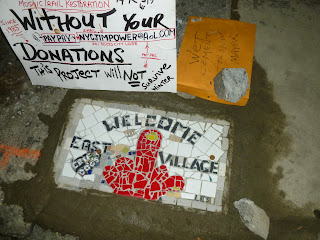
some months ago
Reader Lynne Lieberman checked in with the workers, who told her, "It will be a sales office and model apartment for the new St. Vincent's Hospital condominiums & that nothing else will go in there for at least 2 years." After that, it could become a Gap--though the worker who said that might've been yanking our chain.
Completed, the sales office has now opened for business.

There is no sign to mark its presence, just opaque white curtains covering the windows, the number 450 in elegant gold leaf on the doors, and a man in a suit and tie who opens the gates, one supposes, for those who look like they can afford a $29 million penthouse.
Very exclusive.

Jefferson Market, opened in 1929 and long beloved by Villagers, closed in 2008 for "restructuring." It reopened in 2009 as a Gristede's in mom-and-pop disguise. That closed in 2011 and Catsimatidis said he was considering reopening it again, this time as a full-on Gristede's, but that didn't happen. It was used briefly to house a temporary Halloween costume shop.
And now the shell of a once vital business is being used to sell uber-luxury homes built into the shell of a once vital hospital.
"Live exactly where you want," with "a staggering array of private amenities," say the big, splashy ads. (Check out the website if you want to have a conniption.) At the construction site this week, Yetta Kurland snapped this bit of graffiti--before it promptly disappeared:



















































